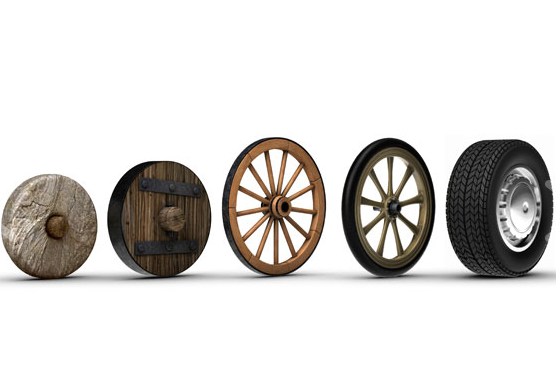How specialty application tires have evolved over the years
treadworldcs2023-12-07T23:14:36-06:00
How Specialty Application Tires Have Evolved
Not surprisingly, the evolution of trailer tires, ag tires, ATV tires, lawn & garden tires and other specialty tires fits hand in glove with the evolution of the wheel. The earliest historical mention of wheels is from the Neolithic era, around 3500 BC, and the earliest tires were likely leather bands wrapped around a stone or wooden wheel. The introduction of wagons heading west led to wheels made of hickory or oak with iron bands, which as you can imagine, were very uncomfortable, and not particularly reliable.
That changed when Charles Goodyear patented the vulcanization process in 1844. Vulcanization revolutionized tires by turning rubber from a gooey, milky rubber sap extracted from a plant into a hardened material that could withstand heat and cold without melting or cracking. That led to solid rubber tires which, though they stood up to cuts and abrasions, were heavy, did not absorb shock well, and provided anything but a smooth ride. In 1847, a Scottish engineer patented the first air-filled tire, but it wasn’t until 1888 that John Dunlop created the first pneumatic tire in an effort to smooth out his son’s tricycle ride. Over the next few decades, tires were developed for a multitude of different types of vehicles including the first gas-powered cars which like the tricycle, had three wheels. Tread tires were introduced in 1905, to protect the tire carcass from direct road contact, inner tubes came into wide use in the 1920s, winter tires were introduced in Finland in 1934 to provide safety in stormy weather, and radial tires first appeared in Europe in 1948.
That’s All Fun Information, but What About Today’s Treadworld Tires?
What’s really relevant is how all this history leads to the top quality Treadworld Tires you’ll find here, the ag tires, tractor tires and other farm implement tires, trailer tires, ATV tires, skid steer tires, forklift tires, lawn and garden tires, wheelbarrow tires, all of the tires you use daily. Computers play a vital role in designing our tires. Sophisticated computer programs help us devise the most effective Master and Rubbermaster compounds, simulate tread performance in actual conditions, and estimate the effects of different everyday stresses each tire may encounter. Quality control permeates every step of the Treadworld tire manufacturing process starting with testing done by the suppliers of the raw materials before delivery, to testing by chemists once the materials reach the factory, to an extensive series of tests that take place during the manufacturing process to insure top performance characteristics and puncture resistance, to (finally!) the x-rays that verify each tire is perfect.
The Treadworld Tire Story Isn’t Complete
Whether you’re looking for lawn mower tires, forklift tires, or tires for your golf cart, you can depend on Treadworld to provide the best in quality and performance, guaranteed, for tires, wheels and tubes. We’re constantly working on improving rubber chemistry and tire design as we strive to provide you with tires that you can depend on for reliable traction in all weather conditions, and that will last longer, while ensuring your safety in any application.
